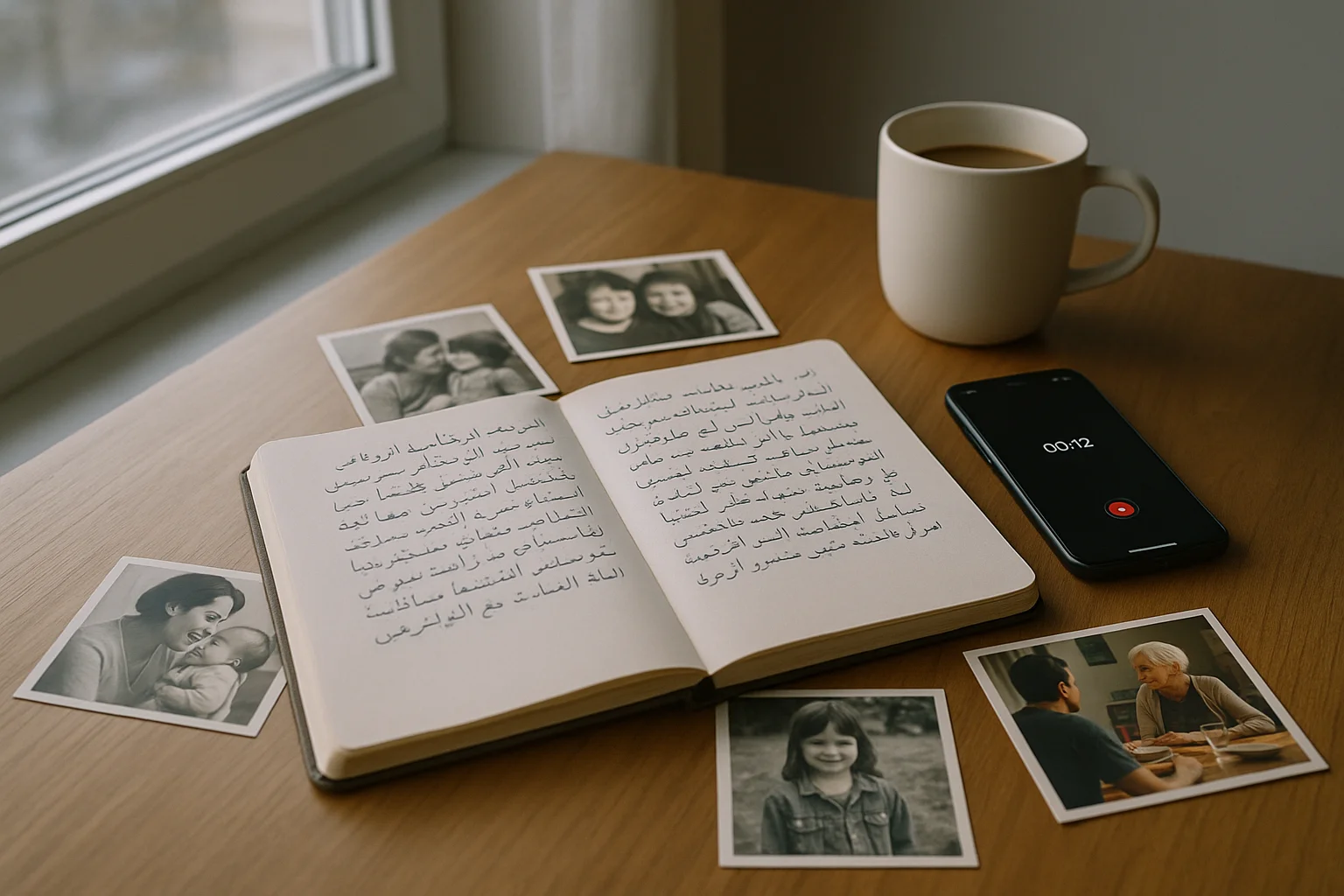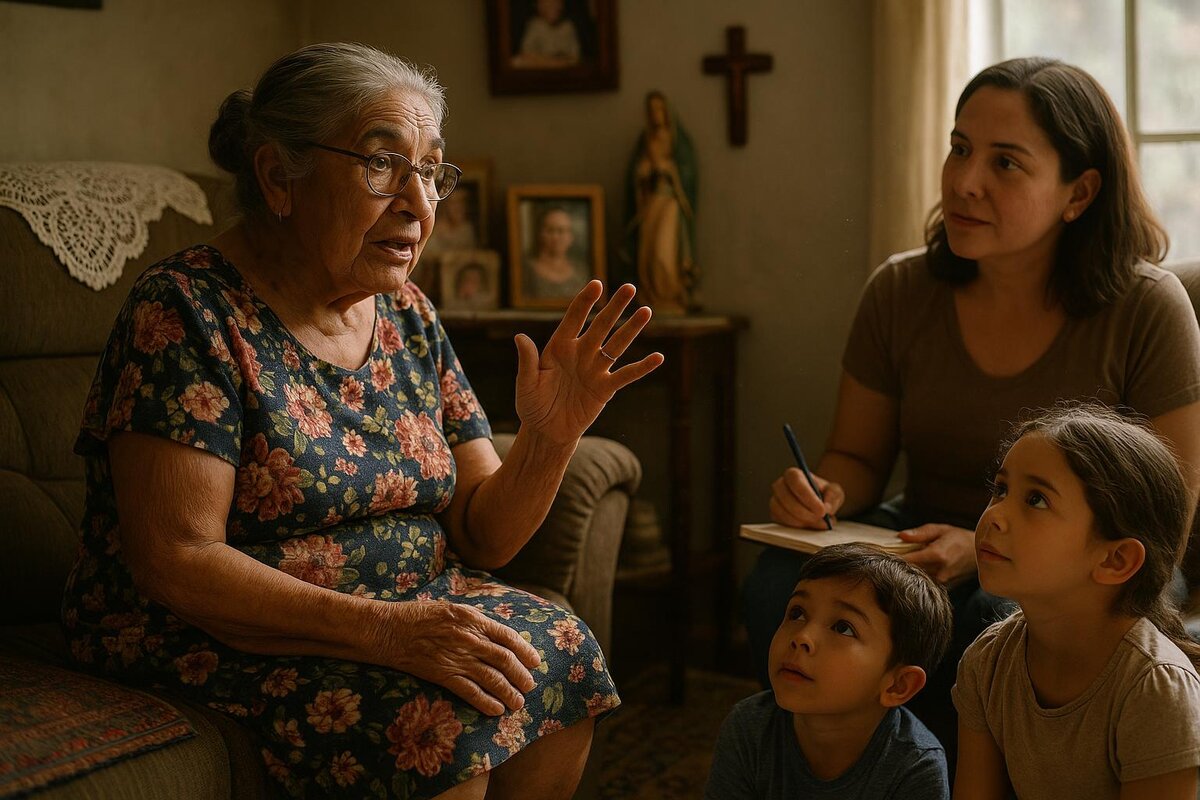
We can't find the internet
Attempting to reconnect
Something went wrong!
Hang in there while we get back on track
Family Heritage
How to Turn Spanish-Speaking Parents' Oral Traditions into Written Family Histories

Your parents carry decades of rich stories—tales of migration, family traditions, cultural celebrations, and life lessons passed down through generations. These oral traditions represent the heart of your family's heritage, yet they risk being lost forever if they remain unrecorded.
For bilingual families, the challenge becomes even more complex: how do you preserve Spanish-language oral traditions in a format that honors the original culture while remaining accessible to English-speaking grandchildren?
This comprehensive guide explores practical, culturally-sensitive approaches to transforming your parents' spoken memories into lasting written family histories that bridge language barriers and preserve your heritage for future generations.
Understanding the Urgency: Why Oral Traditions Matter
Hispanic and Latino families have traditionally preserved family history through dichos (sayings), cuentos (stories), and oral narratives that capture not just events, but the emotional essence of experiences. These stories often include:
- Immigration journeys and the challenges of starting over in a new country
- Cultural traditions specific to regions, towns, or family customs
- Family recipes with stories behind special occasion meals
- Historical context about events that shaped their generation
- Life lessons embedded in parables and personal experiences
- Extended family connections that may span multiple countries
When these stories remain unrecorded, families lose more than just facts—they lose the cultural context, emotional depth, and unique perspectives that define their identity.
Cultural Considerations for Preserving Hispanic Family History
Respecting Storytelling Traditions
In many Spanish-speaking cultures, storytelling follows specific patterns and includes cultural elements that may not translate directly to English. When preserving these stories, consider:
Language Nuances: Certain Spanish expressions, regional dialects, and cultural references carry meanings that extend beyond literal translation. Preserving these elements while making stories accessible requires thoughtful approach.
Generational Respect: Traditional Latino culture emphasizes respect for elders (respeto). The process of recording stories should honor this value by allowing parents to share in their preferred format and timeline.
Community Context: Many stories reference extended family networks, compadrazgo systems, and community relationships that may need explanation for younger generations.
Addressing Sensitive Topics
Older generations may have experienced:
- Political upheaval or persecution in their home countries
- Economic hardship or discrimination
- Family separation due to immigration
- Cultural identity challenges in adapting to American life
These experiences require careful, empathetic handling when being documented for family histories.
Methods for Capturing Spanish Oral Traditions
1. Family-Led Recording Sessions
DIY Approach: Family members conduct and record interviews themselves.
Best Practices:
- Use quality recording equipment or smartphone apps
- Create comfortable, familiar environments for storytelling
- Prepare thoughtful questions that prompt detailed responses
- Allow natural conversation flow rather than rigid interviews
Cultural Tips:
- Share meals during recording sessions to create natural storytelling moments
- Include multiple family members to trigger collaborative memory-sharing
- Record in Spanish for authenticity, translate separately
Challenges:
- Can be time consuming to transcribe, translate and edit into stories
- Difficult to schedule family members to record
- Easy to get fatigued and give up
2. AI-Powered Memoir Services
Innovative Approach: Services like Tell Mel use conversational AI to conduct phone interviews in Spanish, then create professionally written memoir chapters in English.
How It Works:
- AI interviewer calls your parents on a telephone weekly
- Conversations happen entirely in Spanish (or their preferred language)
- Stories are automatically transcribed and translated
- Professional memoir chapters created in both their native language and English
- Family receives both original audio and written versions
Benefits:
- No technology learning curve for elderly parents
- Cultural sensitivity built into conversation approach
- Professional-quality final product
- No need to transcribe, translate and edit into stories
- Preserves both Spanish authenticity and English accessibility
- No hassles about scheduling family members to record
3. Professional Transcription Services for Family History
Traditional Approach: Hire bilingual transcription services that specialize in family history documentation.
Pros:
- Professional quality transcription
- Cultural sensitivity training
- Both Spanish and English versions available
Cons:
- Expensive for extensive family histories
- May lack personal touch and family-specific context
- Difficult to find quality bilingual translators
- Requires coordination with external service providers
Creating Culturally Respectful Written Histories
Translation Strategies for Documenting Oral Traditions
Maintain Cultural Integrity: Rather than literal translation, focus on conveying the spirit and meaning of stories while noting important Spanish terms and phrases.
Include Explanations: Add a glossary of definitions of cultural terms, family nicknames, and regional expressions that English readers may not understand or make sure to include those definitions in the writeups
Preserve Voice: Maintain the storyteller's natural speech patterns and expressions that reflect their personality and cultural background.
Structure for Bilingual Family Histories
Chronological Organization:
- Early life in country of origin
- Immigration journey and early American experiences
- Family building and cultural adaptation
- Lessons learned and wisdom gained
Thematic Organization:
- Family traditions and celebrations
- Work and economic experiences
- Education and learning
- Community involvement and relationships
Making Stories Accessible to English-Speaking Grandchildren
Age-Appropriate Formatting
For Young Children (5-10 years):
- Simplified language and shorter story segments
- Focus on adventure and family traditions
- Include visual elements and illustrations
- Create interactive elements like family tree activities
For Teenagers (11-17 years):
- Include historical context to help them understand their heritage
- Focus on themes of resilience, identity, and belonging
- Connect past experiences to current challenges they might face
- Encourage questions and discussion
For Young Adults (18+ years):
- Provide complete, unedited stories with full cultural context
- Include lessons about financial responsibility, career building, and family values
- Connect family history to broader historical events
- Encourage them to contribute their own stories to continue the tradition
Professional vs. DIY Approaches
When to Choose DIY Methods
Best For:
- Families with ample available time and technical skills. Expect dozens of hours of recording and editing.
- Limited budgets
- Strong family coordination abilities
- Parents comfortable with technology and talking to their children
When to Choose An AI Interviewer
Best For:
- Busy families with limited time
- Families who want an expert to dig further into their parents' histories
- Elderly parents who struggle with technology
- Families wanting professional-quality final products
Services to Consider:
- Tell Mel: AI-powered phone interviews in Spanish with English memoir creation
- Traditional memoir services: Human interviewers and professional writing
- Transcription services: Professional translation and cultural sensitivity
- Hybrid approaches: Combination of family involvement and professional assistance
Taking the First Step
The most important step in preserving your family's oral traditions is simply beginning. Whether you choose a high-tech solution, traditional recording methods, or professional services, the key is starting the conversation.
Immediate Actions You Can Take:
- Have a family discussion about the importance of preserving these stories
- Begin with informal recording sessions during family gatherings
- Research professional services that align with your family's needs and budget
- Start collecting photos and documents that can supplement oral histories
- Create a list of key family stories and cultural traditions you want to preserve
Remember: The perfect solution is the one that actually gets implemented. Choose an approach that works for your family's unique circumstances, timeline, and comfort level.
Conclusion: Bridging Generations Through Story
Preserving your Spanish-speaking parents' oral traditions as written family histories is more than just documentation—it's an act of love that bridges generations and cultures. Whether you choose DIY recording methods, professional transcription services, or innovative AI-powered memoir services like Tell Mel, the goal remains the same: ensuring that your family's rich cultural heritage continues to inspire and guide future generations.
The stories your parents carry represent irreplaceable treasures of experience, wisdom, and cultural identity. By taking action now to preserve these oral traditions in accessible written formats, you're giving your English-speaking grandchildren—and all future generations—the gift of understanding where they come from and the strength that flows through their family line.
Your family's stories deserve to be preserved. The question isn't whether to begin this important work, but which approach will work best for your unique family situation. Start today, and give your grandchildren the heritage they deserve to inherit.
Ready to Preserve Your Family's Stories?
Looking for the easiest way to preserve your Spanish-speaking parents' stories? Tell Mel offers AI-powered phone interviews in Spanish that create beautifully written English memoir chapters. No apps, no technology learning—just meaningful conversations that become cherished family histories.
Learn More About Tell Mel →